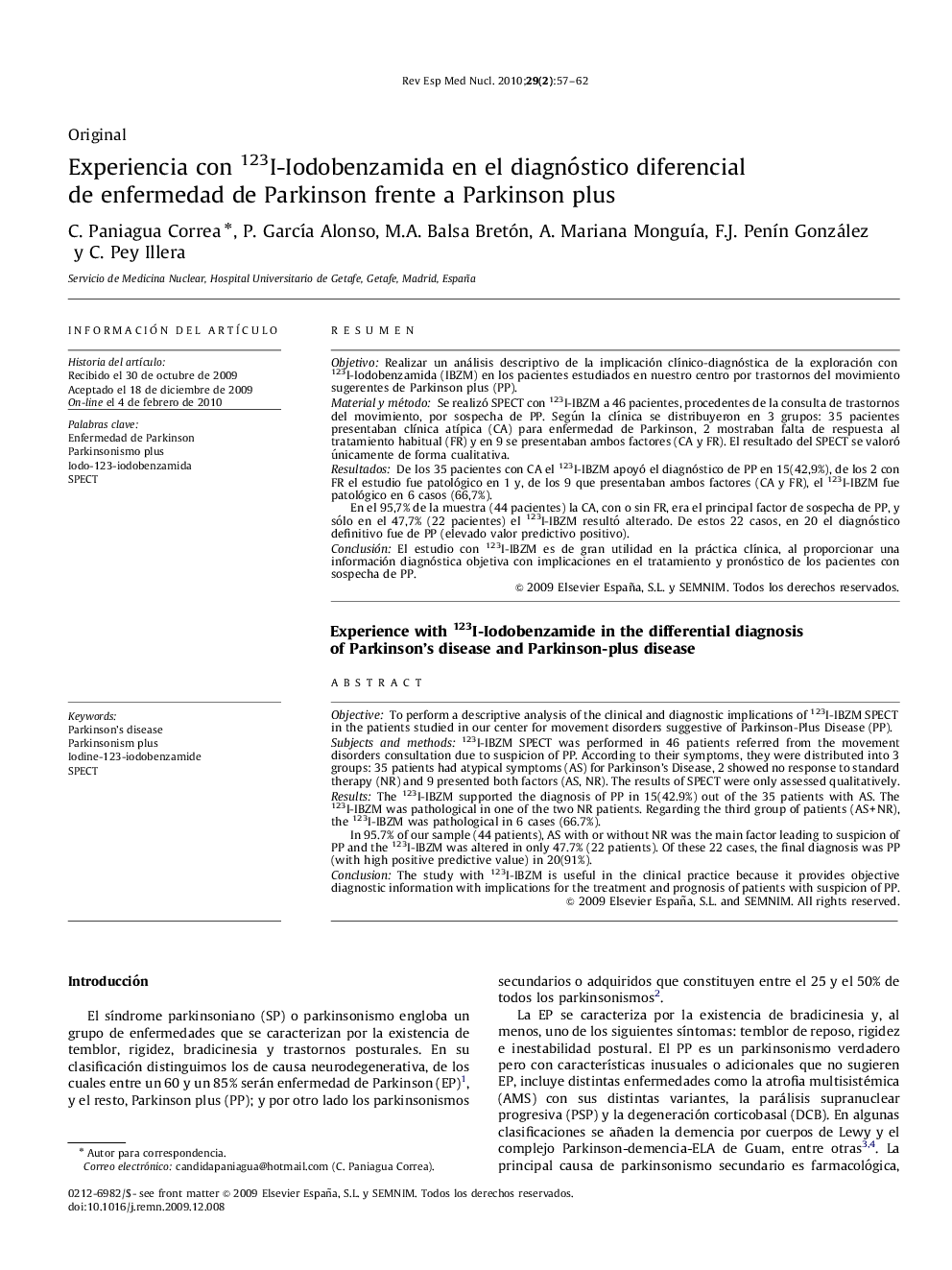| Article ID | Journal | Published Year | Pages | File Type |
|---|---|---|---|---|
| 4248958 | Revista Española de Medicina Nuclear | 2010 | 6 Pages |
ResumenObjetivoRealizar un análisis descriptivo de la implicación clínico-diagnóstica de la exploración con 123I-Iodobenzamida (IBZM) en los pacientes estudiados en nuestro centro por trastornos del movimiento sugerentes de Parkinson plus (PP).Material y métodoSe realizó SPECT con 123I-IBZM a 46 pacientes, procedentes de la consulta de trastornos del movimiento, por sospecha de PP. Según la clínica se distribuyeron en 3 grupos: 35 pacientes presentaban clínica atípica (CA) para enfermedad de Parkinson, 2 mostraban falta de respuesta al tratamiento habitual (FR) y en 9 se presentaban ambos factores (CA y FR). El resultado del SPECT se valoró únicamente de forma cualitativa.ResultadosDe los 35 pacientes con CA el 123I-IBZM apoyó el diagnóstico de PP en 15(42,9%), de los 2 con FR el estudio fue patológico en 1 y, de los 9 que presentaban ambos factores (CA y FR), el 123I-IBZM fue patológico en 6 casos (66,7%).En el 95,7% de la muestra (44 pacientes) la CA, con o sin FR, era el principal factor de sospecha de PP, y sólo en el 47,7% (22 pacientes) el 123I-IBZM resultó alterado. De estos 22 casos, en 20 el diagnóstico definitivo fue de PP (elevado valor predictivo positivo).ConclusiónEl estudio con 123I-IBZM es de gran utilidad en la práctica clínica, al proporcionar una información diagnóstica objetiva con implicaciones en el tratamiento y pronóstico de los pacientes con sospecha de PP.
ObjectiveTo perform a descriptive analysis of the clinical and diagnostic implications of 123I-IBZM SPECT in the patients studied in our center for movement disorders suggestive of Parkinson-Plus Disease (PP).Subjects and methods123I-IBZM SPECT was performed in 46 patients referred from the movement disorders consultation due to suspicion of PP. According to their symptoms, they were distributed into 3 groups: 35 patients had atypical symptoms (AS) for Parkinson's Disease, 2 showed no response to standard therapy (NR) and 9 presented both factors (AS, NR). The results of SPECT were only assessed qualitatively.ResultsThe 123I-IBZM supported the diagnosis of PP in 15(42.9%) out of the 35 patients with AS. The 123I-IBZM was pathological in one of the two NR patients. Regarding the third group of patients (AS+NR), the 123I-IBZM was pathological in 6 cases (66.7%).In 95.7% of our sample (44 patients), AS with or without NR was the main factor leading to suspicion of PP and the 123I-IBZM was altered in only 47.7% (22 patients). Of these 22 cases, the final diagnosis was PP (with high positive predictive value) in 20(91%).ConclusionThe study with 123I-IBZM is useful in the clinical practice because it provides objective diagnostic information with implications for the treatment and prognosis of patients with suspicion of PP.
